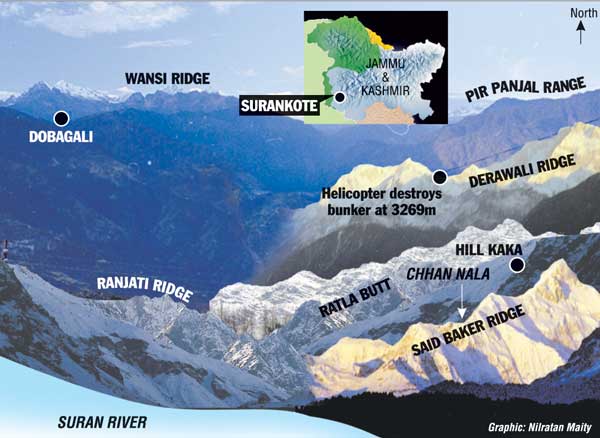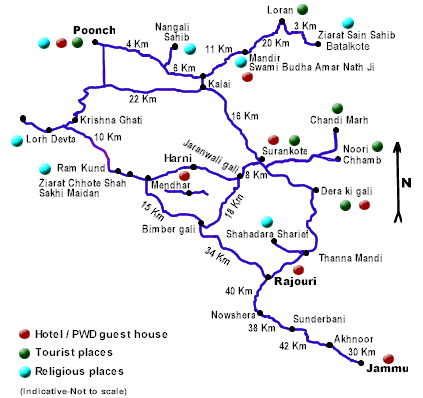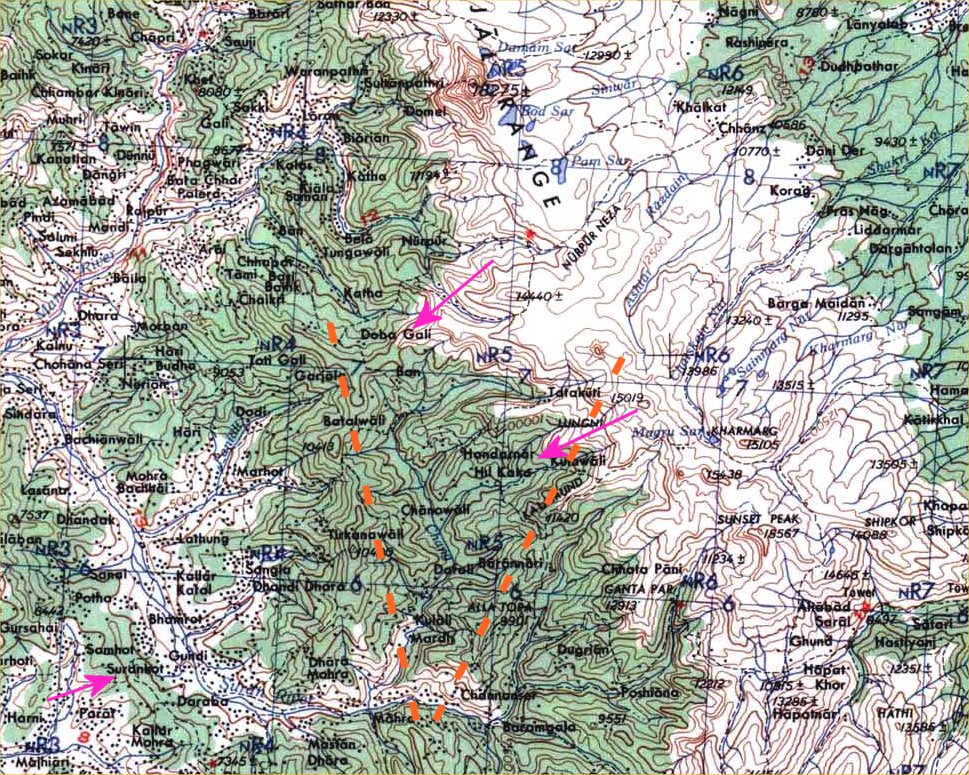About the Site
Operation Sarp Vinash
- Details
- Created: 12 October 2006
- Written by Y I Patel
- Hits: 40036
The counterterrorism operation Sarp Vinash (Operation Destroy Serpents) was carried out in four phases, from January to May 2003. The operation took place in the Surankote area of the Pir Panjal Range that separates the Kashmir valley from Jammu. The operations were initially conducted in the region bounded by the Ranjati, Wansi, and Said Baker ridges (Figure 1).[1] The target of the operations was a terrorist complex southwest of Poonch (Figure 2, Figure 3). The main portion of the terrorist complex was near the village of Hilkaka, a center for transient Bakarwal herders.

Figure 1: An aerial view of the area of operations
(fromhttp://www.telegraphindia.com/1030524/asp/nation/story_2000769.asp)

Figure 2 : A map of the Poonch district
(from http://poonch.nic.in/map/map.htm)

Figure 3 : Detailed topographic map of the region
(based on US Army Topographic Service Maps, courtesy Manku Thimma)
http://www.geocities.com/mthimma/sarpvinash.html
Key Features of the Operation
The operation was carried out primarily by Counter Insurgency Force (R). CIF (R) is commonly referred to as Romeo Force. The operation took place in four phases. In the first phase, from about November 2002 to January 2003, CIF(R) developed the physical infrastructure necessary for conduct of operations, by constructing helipads and mule tracks. In the second phase, bases surrounding the target region were established, and migrant herders from the area were resettled elsewhere and compensated by the state government. Around 21 April 2003, in the third phase, a cordon was thrown around the entire region to prevent any unauthorized entry or exit into the Hilkaka area and the forces moved in to attack or occupy tactically vital positions within the area. Finally, in the fourth phase (which began on 3 May 2003), attacks and sweeps were mounted to eliminate terrorists taking shelter in the area [2] .
The operation resulted in extermination of about 65 terrorists and the loss of some 4 soldiers. Army estimates indicated about 100 terrorists in the Hilkaka area, and some 3,500 in the state at any time3 . The 9th Battalion of the Parachute Regiment (Special Forces) played a vital role in leading the attacks on terrorist bases, and they were supported by sweeps and ambushes mounted by six other units of 163 Infantry Brigade (Thana Mandi Brigade) and 12 Sector Rashtriya Rifles: 2/4 Gorkha Rifles, 15 Garhwal Rifles, 4 Garhwal Rifles, 16 and 20 Rashtriya Rifles [3] . Follow-up operations have been planned to exploit the success of Sarp Vinash [4] .
Analysis
The purpose and potential impact of operations undertaken in Sarp Vinash can be understood by reviewing the geography and recent history of the Poonch and Rajauri districts. These districts are isolated from rest of India by the steep flanks and thick forests of the Pir Panjal range. At the same time, the spurs of the Pir Panjals are in Pakistan Occupied Kashmir, and they provide easy and sheltered access for terrorists infiltrating into Indian territory. The inaccessibility of vast tracts within the Pir Panjals, and the inadequacy of civilian government institutions, has made them a terrorist sanctuary [5] .
The Indian security forces can, at best, contain terrorism in these areas by mounting area dominance patrols in the surrounding lowlands and periodically mounting operations to flush out terrorists from their mountain lairs, even for the Surankote area [6] ,[7] ,[8] . Most notably, 6 Infantry Division conducted sweeps of the region after Operation Vijay, in 1999 [9] . However, since the thinly stretched security forces have lacked adequate manpower, the gains of the flushing operations have been fleeting. The winter months, in particular, large parts of the region are totally cut off from the rest of the country.
As a result, the terrorists escape to sanctuaries in the upper reaches of the Pir Panjals, and spend the winter months recuperating and rebuilding for another season of terror. The presence of migratory Bakarwals and Gujjars in the region further complicates anti-terrorism efforts. Many of these herders have been bribed or intimidated into becoming the eyes and ears of the terrorists and their Pakistani mentors. Furthermore, terrorists can evade detection by disguising themselves as herders. The remoteness of the region and harshness of terrain exacerbate the difficulty of anti-terrorist sweeps. Since military forces have to patrol over well-known trails, their approach can be detected by well placed lookouts. The terrain affords plenty of places for the terrorists to melt into, once they have been forewarned of the approach of security forces. Finally, the weakness of civilian government and lack of adequate police forces means that quality intelligence is not available on the movements and lairs of terrorists in these areas.
Pakistani terrorists took advantage of the adverse geography of the region to build up important terrorist nodes in this area. Bases destroyed during Sarp Vinash contained large stocks of foodstuffs, communications equipment, arms, ammunition, and even medicines [10] . The nature and quantity of supplies and the presence of bunkers has led to media comparisons with Kargil infiltrations. Such comparisons are fundamentally flawed because terrorists operate very differently from regular military units. All insurgencies, even those in the destabilisation phase (i.e. as opposed to the full blown guerrilla and conventional phases), require logistical bases to sustain them. Unlike the Kargil intrusion, these kinds of retreats have existed in the State's more remote areas from almost the beginning of the insurgency in 1989. Terrorists have no interest in holding territory, and they are unlikely to stand and fight like regular army units. Their survival depends on being elusive and mobile; their bases are chosen not for dominating territory but for ease of concealment. The rugged terrain along the LOC makes a total cap on cross-border infiltration impossible, so there is no way that security forces can prevent well concealed support bases such as the ones in Hilkaka from coming up. In such a situation, security forces have to rely on patrols, anti-terrorist sweeps, and intelligence to keep such bases from taking root, much as gardeners have to be continuously vigilant against weeds.
The Rashtriya Rifiles (RR) were raised to free regular army units from counter terrorism duties, and to operate in these remote areas. CIF (R) came into being after Kargil, to relieve 39 Mountain Division of counter terrorism duties and to act in concert with CIF (D) (Delta Force) and CIF (V) (Victor Force). Recently, as a result of continuing raisings of new RR formations post-Kargil, the CIF (U) (Unicorn Force) was raised to further augment RR presence in the Pir Panjal region. The scale of manpower requirements for policing the Pir Panjals can be gauged from the fact that more than a corps equivalent of RR formations is now operational in the area: CIF (R) in Rajauri area, CIF (D) in Doda area, CIF (V) in southern Kashmir Valley, and CIF (U) in the Udhampur/Banihal area. During Operation Parakram, about four infantry divisions were moved to Northern Command areas. At least one of these (27 Mountain Division) is known to have stayed behind even after Operation Parakram wound down. CIF (R), the force responsible for mounting Sarp Vinash, is currently estimated to operate in the Rajauri region. The other forces with operational areas abutting CIF (R) operations area are estimated to be 25 Infantry Division to the west and north, CIF (V) to the northeast, CIF (D) to the east, and CIF (U) to the south and southeast.
Sarp Vinash is a watershed in counterterrorist operations because it represents the crystallization of three positive trends in India's conduct of its war against terrorism: the steady rise in dedicated anti-terrorist force strengths and improvement in their fighting ability through specialized training, weaponry, and intelligence gathering means; greater attention to development of infrastructure; and a substantial improvement in the political climate of the valley following the 2002 state assembly elections.
As previously noted, Indian security forces have been unable to do more than containing terrorism in the Pir Panjals due to the vastness and inaccessibility of the region. While India does field substantial military and para-military forces, the intrusions in the Kargil region brought forth the realization that the forces were thinly stretched and inadequate for the task of manning the harsh terrain of Jammu, Kashmir and Ladakh [11] . This resulted in the belated but wise decision to significantly ramp up force levels in paramilitary forces such as RR, Assam Rifles, BSF, and CRPF, with a view to free the army up from anti-terrorist duties. Since 1999, an estimated 20 battalions of RR have been raised, and force levels in the other paramilitary agencies have also witnessed similar increases. The manpower levels are finally approaching the critical mass required to effectively take the war to the terrorists in the Pir Panjals. Perhaps the most significant difference between Sarp Vinash and previous operations is that an additional 10 battalions were introduced to the Pir Panjal area after the conclusion of Phase 4 of Sarp Vinash [12] . One battalion will be stationed in the area even after the mopping-up operations are completed. The permanently deployed battalion will ensure that the gains of Sarp Vinash are not fleeting, as in previous occasions when terrorists managed to regroup in the area after sweeps by security forces.
The increased force levels have also been accompanied by a steady buildup of infrastructure to support them. The laying of tracks and building of helipads in preparation of Sarp Vinash indicates that the intent of security forces is to secure their gains by improving accessibility, and thereby permitting security forces greater mobility and logistic sustenance. This focus on improving infrastructure as a means of denying terrorists freedom of movement is also seen on a broader scale. To prevent Pakistan backed infiltration efforts, BSF battalions continue to build fences on the international border in the Jammu area, despite Pakistani shelling. The army also has plans to install surveillance devices along the Line of Control, and to block known infiltration routes with barbed wire fences [13] . Improved infrastructure acts as a force multiplier by affording greater mobility to security forces, fewer hiding places for terrorists, and fewer reasons for the general populace to be disgruntled against the government or intimidated by terrorists.
The second positive trend is the upgradation of skills and weaponry within the security forces. The training of anti-terrorist forces has been upgraded; special automatic weapons, night vision devices, battlefield surveillance radars, and other monitoring devices are being procured [14] . The ability of security forces to mount night operations has improved dramatically, as shown by the high success rate in killing terrorists. Sarp Vinash was more of an intelligence-driven operation rather than a fruitless jungle-bashing sweep, as was the case for operations of this scale in the past. In Sarp Vinash itself, far greater reliance was placed on intelligence collection through high-tech equipment such as UAVs, and in general, Army sources have been quoted as saying that in recent times almost 70% of terrorist kills along the LOC [15] could be attributed to better intelligence. The increased capability in intelligence gathering, in particular, can act as a tremendous force multiplier by positively impacting the morale of the security forces; bolstering the confidence of local populace in the security forces; and sowing fear, uncertainty and doubt among the ranks of the terrorists.
Finally, the importance of the improved political climate in this troubled Indian state cannot be emphasized enough [16] . The successful conduct of elections in the face of terrorist opposition renewed and bolstered the credibility of India's Kashmir policy, and freed up political and diplomatic space for a far more aggressive stance against Pakistan-sponsored terrorism. The successful resettlement of migrant herders away from Surankote area is evidence of the current government's significant role in creating a new environment in the state that is far more supportive of India's moves to heal the wounds of insurgency than ever before. One definitive indicator of the Kashmiri acceptance of India's sovereignty over Jammu and Kashmir is the success of President of India Abdul Kalam's visit to the state, and the well-attended political rallies held in Kashmir by mainstream Indian political parties such as Congress (I) [17] .
The rejuvenated sense of belonging among local Kashmiris has translated into active support for Indian troops fighting the terrorist menace in the region. Operation Sarp Vinash is reported to have been initiated on the basis of intelligence provided by locals in the Hilkaka area, and it was mounted with the active support and participation of Poonch district citizens who gave up comfortable jobs in the Gulf region to defend their homes against terrorists [18] . In an economic dimension to the political fight against terrorism, several new infrastructure initiatives, most notably the proposed Rohtang Tunnel project [19] and the construction of a railway line between Udhampur in Jammu and Baramulla in the Valley have been started, to build up the infrastructure to improve accessibility to remote areas of the state. Smaller and less visible projects have also been undertaken since 1999 to improve accessibility to posts on the LOC in previously inaccessible areas. The economic boost provided by these projects (through direct employment as well as increased opportunities for year-round commerce and tourism) will further help in improving the lot of the people of Jammu and Kashmir, and reduce their sense of isolation from the Indian heartland.
Conclusion
Operation Sarp Vinash was certainly not the first counter-terrorist operation of its type or scale. There have been other similar operations in the Indian State of Jammu and Kashmir. What set Sarp Vinash apart from the other operations was the meticulous groundwork laid before the operation commenced, and the follow up steps taken after the conclusion of the first phase of the operation, to consolidate gains. The operation is a coming of age story for the Rashtriya Rifles Force Headquarters, which have now have the resources to mount and lead division level operations of their own. The scale of operations and their attendant success were made possible by several ongoing trends in India's counter-terrorism strategy: a willingness to invest in dedicated manpower, attention to infrastructure development for supporting counter-terrorism operations, better equipment and training of forces, and last but not least, a dramatically improved political climate in the state that supports anti-terrorist efforts.
The national and state administrations and their security and intelligence services deserve to be congratulated on a well-conceived and executed operation. It is hoped that the success of this operation will be a harbinger of even greater victories against the global scourge of terrorism. The best benchmark for the success of the operation would be reduction in terrorist activity emanating from bases in the Hilkaka area. While this may not translate into improved statistics in the fight against terrorism in the short run, the positive opportunities created by the removal of an ever-present threat should do wonders for the development and well being of the people of Poonch in particular, and the people of the troubled state of Jammu and Kashmir in general.
Acknowledgements
The author would like to thank Mr Johann Price for his insightful comments and his help in enhancing the quality of the article, and Gen Afsir Karim for his painstaking review. Members of Bharat Rakshak Forum, particularly Mr Sunil, provided links that eased the author's burden of collecting references, and Mr Manku Thimma kindly provided an annotated topographical map to accompany the article. The thoughts expressed in this article are the author's personal opinions, and they do not reflect the views of his employers, or of the administrators of Bharat Rakshak Forum and Bharat Rakshak Monitor. Any factual errors are the author's responsibility.
References
- Sujan Datta, Operation Sarp Vinash: A guided tour, The Telgraph
http://www.telegraphindia.com/1030524/asp/nation/story_2000769.asp - Josy Joseph, Operation 'Sarp Vinash': Over 60 terrorists killed, Rediff.com
http://in.rediff.com/news/2003/may/23josy1.htm - Maj Gen Ashok Mehta (retired), Time to Terrorise the Terrorist, The Daily Pioneer
http://www.dailypioneer.com/columnist1.asp?main_variable=Columnist&file_name=mehta%2Fmehta12%2Etxt&writer=mehta - Army to launch "Operation Sarp Vinash II" in JK
ttp://news.indiainfo.com/2003/05/27/27army.html - Praveen Swamy, Frontline, Catch Them Young
http://www.hinduonnet.com/fline/fl1824/18240680.htm - http://www.dailyexcelsior.com/01june26/news.htm
- http://www.dailyexcelsior.com/01july16/news.htm#9
- http://www.dailyexcelsior.com/01july16/news.htm#2
- Kanwar Sandhu, Security forces skate on J-K's thin ice, Indian Express
http://www.indianexpress.com/ie/daily/19991207/ifr07044.html - The Pioneer Edit Desk, Serpents Defanged, The Pioneer, 26 May 2003
- We didn't have enough men to bust terror base: Army, Hindustan Times
http://hindustantimes.com/news/181_262599,0008.htm - http://www.indianexpress.com/full_story.php?content_id=24893
- Sandeep Dikshit, The Hindu, 21 May 2003 India starts blocking infiltration routes
- Thermal imagers to aid army operations, NDTV online report
http://www.ndtv.com/morenews/showmorestory.asp?slug=Thermal+imagers+to+aid+army+operations&id=39095 - Varsha Bhosle, The Lamb That Roared
http://www.rediff.com/news/2003/may/26varsha.htm - Joanna Slater, The Far Eastern Economic Review (6/19) Kashmiris and Tourists Share New Sense of Optimism
- Gandhi in rare Kashmir address, BBC News World Edition
http://news.bbc.co.uk/2/hi/south_asia/2949088.stm - Arun Sharma, The Indian Express, Hilkaka's untold story: NRIs came home to fight terrorists
http://www.indianexpress.com/full_story.php?content_id=25817 - Tribune News Service, PM Announces Rhotang Tunnel
http://www.tribuneindia.com/2000/20000604/main1.htm
 About the Site
About the Site